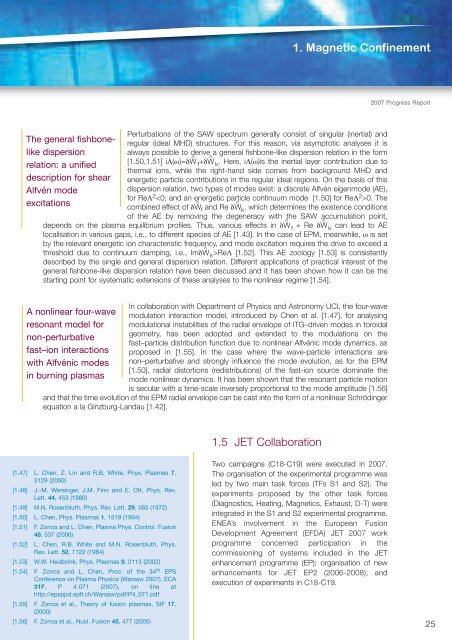Fusion Programme - ENEA - Fusione
Fusion Programme - ENEA - Fusione
Fusion Programme - ENEA - Fusione
- No tags were found...
Create successful ePaper yourself
Turn your PDF publications into a flip-book with our unique Google optimized e-Paper software.
1. Magnetic Confinement2007 Progress ReportThe general fishbonelikedispersionrelation: a unifieddescription for shearAlfvén modeexcitationsPerturbations of the SAW spectrum generally consist of singular (inertial) andregular (ideal MHD) structures. For this reason, via asymptotic analyses it isalways possible to derive a general fishbone-like dispersion relation in the form[1.50,1.51] iΛ(ω)=δW^ +δW^ f k . Here, iΛ(ω)is the inertial layer contribution due tothermal ions, while the right-hand side comes from background MHD andenergetic particle contributions in the regular ideal regions. On the basis of thisdispersion relation, two types of modes exist: a discrete Alfvén eigenmode (AE),for ReΛ 2 0. Thecombined effect of δW^ f and Re δW^ k , which determines the existence conditionsof the AE by removing the degeneracy with the +ReδW^ SAW accumulation point,f k can lead to AEdepends on the plasma equilibrium profiles. Thus, various effects in δW^localisation in various gaps, i.e., to different species of AE [1.43]. In the case of EPM, meanwhile, ω is setby the relevant energetic ion characteristic frequency, and mode excitation requires the drive to exceed athreshold due to continuum damping, i.e., ImδW^ k >ReΛ [1.52]. This AE zoology [1.53] is consistentlydescribed by the single and general dispersion relation. Different applications of practical interest of thegeneral fishbone-like dispersion relation have been discussed and it has been shown how it can be thestarting point for systematic extensions of these analyses to the nonlinear regime [1.54].In collaboration with Department of Physics and Astronomy UCI, the four-waveA nonlinear four-wave modulation interaction model, introduced by Chen et al. [1.47], for analysingresonant model for modulational instabilities of the radial envelope of ITG–driven modes in toroidalgeometry, has been adopted and extended to the modulations on thenon-perturbativefast–particle distribution function due to nonlinear Alfvénic mode dynamics, asfast–ion interactions proposed in [1.55]. In the case where the wave-particle interactions arewith Alfvénic modes non–perturbative and strongly influence the mode evolution, as for the EPM[1.50], radial distortions (redistributions) of the fast-ion source dominate thein burning plasmas mode nonlinear dynamics. It has been shown that the resonant particle motionis secular with a time-scale inversely proportional to the mode amplitude [1.56]and that the time evolution of the EPM radial envelope can be cast into the form of a nonlinear Schrödingerequation a la Ginzburg-Landau [1.42].1.5 JET Collaboration[1.47] L. Chen, Z. Lin and R.B. White, Phys. Plasmas 7,3129 (2000)[1.48] J.-M. Wersinger, J.M. Finn and E. Ott, Phys. Rev.Lett. 44, 453 (1980)[1.49] M.N. Rosenbluth, Phys. Rev. Lett. 29, 565 (1972)[1.50] L. Chen, Phys. Plasmas 1, 1519 (1994)[1.51] F. Zonca and L. Chen, Plasma Phys. Control. <strong>Fusion</strong>48, 537 (2006)[1.52] L. Chen, R.B. White and M.N. Rosenbluth, Phys.Rev. Lett. 52, 1122 (1984)[1.53] W.W. Heidbrink, Phys. Plasmas 9, 2113 (2002)[1.54] F. Zonca and L. Chen, Proc. of the 34 th EPSConference on Plasma Physics (Warsaw 2007), ECA31F, P 4.071 (2007), on line athttp://epsppd.epfl.ch/Warsaw/pdf/P4_071.pdf[1.55] F. Zonca et al., Theory of fusion plasmas, SIF 17,(2000)[1.56] F. Zonca et al., Nucl. <strong>Fusion</strong> 45, 477 (2005)Two campaigns (C18-C19) were executed in 2007.The organisation of the experimental programme wasled by two main task forces (TFs S1 and S2). Theexperiments proposed by the other task forces(Diagnostics, Heating, Magnetics, Exhaust, D-T) wereintegrated in the S1 and S2 experimental programme.<strong>ENEA</strong>’s involvement in the European <strong>Fusion</strong>Development Agreement (EFDA) JET 2007 workprogramme concerned participation in thecommissioning of systems included in the JETenhancement programme (EP); organisation of newenhancements for JET EP2 (2006-2008); andexecution of experiments in C18-C19.25













